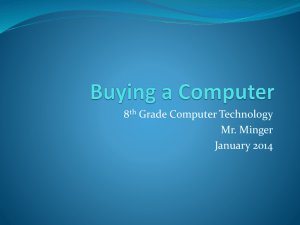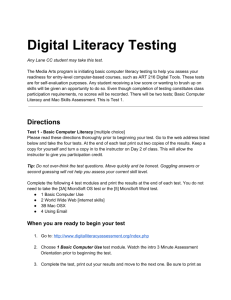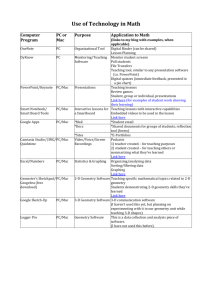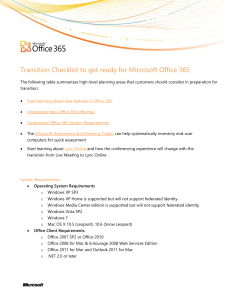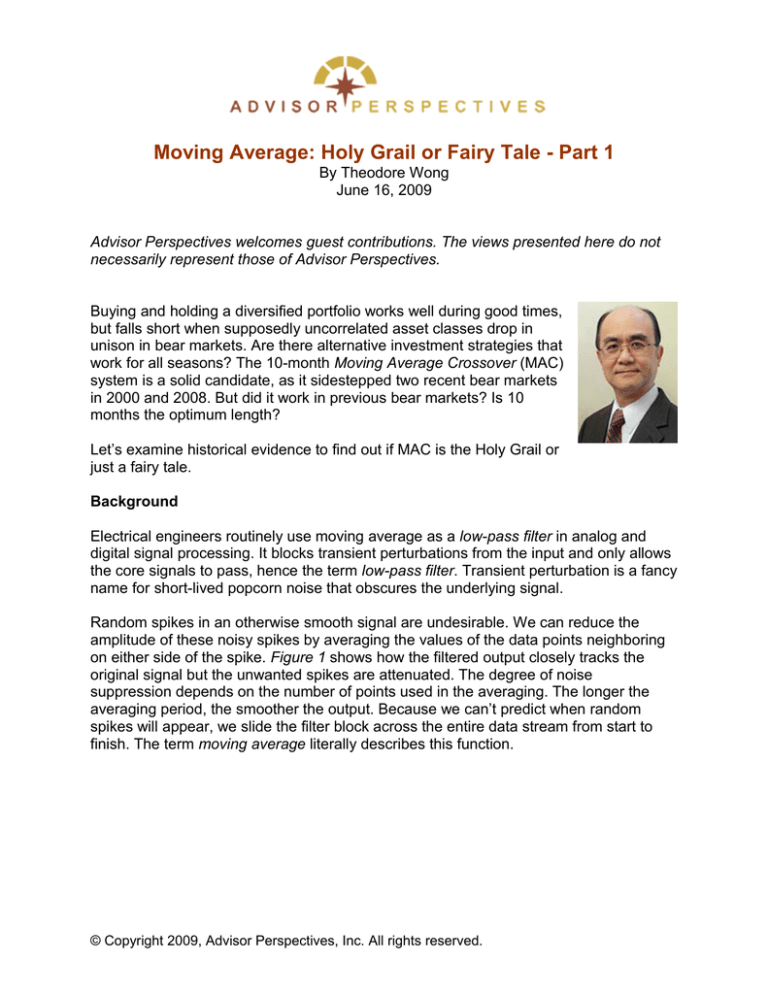
Moving Average: Holy Grail or Fairy Tale - Part 1
By Theodore Wong
June 16, 2009
Advisor Perspectives welcomes guest contributions. The views presented here do not
necessarily represent those of Advisor Perspectives.
Buying and holding a diversified portfolio works well during good times,
but falls short when supposedly uncorrelated asset classes drop in
unison in bear markets. Are there alternative investment strategies that
work for all seasons? The 10-month Moving Average Crossover (MAC)
system is a solid candidate, as it sidestepped two recent bear markets
in 2000 and 2008. But did it work in previous bear markets? Is 10
months the optimum length?
Let’s examine historical evidence to find out if MAC is the Holy Grail or
just a fairy tale.
Background
Electrical engineers routinely use moving average as a low-pass filter in analog and
digital signal processing. It blocks transient perturbations from the input and only allows
the core signals to pass, hence the term low-pass filter. Transient perturbation is a fancy
name for short-lived popcorn noise that obscures the underlying signal.
Random spikes in an otherwise smooth signal are undesirable. We can reduce the
amplitude of these noisy spikes by averaging the values of the data points neighboring
on either side of the spike. Figure 1 shows how the filtered output closely tracks the
original signal but the unwanted spikes are attenuated. The degree of noise
suppression depends on the number of points used in the averaging. The longer the
averaging period, the smoother the output. Because we can’t predict when random
spikes will appear, we slide the filter block across the entire data stream from start to
finish. The term moving average literally describes this function.
© Copyright 2009, Advisor Perspectives, Inc. All rights reserved.
Centered MA vs. Shifted MA
MA Suppresses Noisy Spikes
15
20
Input Data
Input Data
15
Centered MA
5-Point Centered MA
Shifted MA
10
10
5
5
Ce nte re d M A line s up w ith original data
Shifted M A lags be hind original data
0
La g
0
Figure 2
Figure 1
As an engineer, I have always been skeptical of the way stock market technicians plot
MA curves. Traditionally, engineers align the midpoint of the MA curve with the center of
the original data curve. This way, the MA curve is centered with respect to the original
time series as shown by the red curve in Figure 2. Technicians, on the other hand, shift
the end of the MA curve to match the most recent price point as shown by the blue
curve in Figure 2. The lag between the original data curve and the shifted MA curve
created by this peculiar plotting convention is the core of the MAC system. Without
shifting the MA, there is no lag. Without the lag, there is no crossover.
The Moving Average Crossover system
MAC is the simplest and probably the oldest trading system. You buy when the price
rises above its moving average, and you sell when it drops below. Although there are
several forms of moving averages, I prefer the Exponential Moving Average (EMA) to
the Simple Moving Average (SMA) because EMA gives slightly smaller lag.
My assumptions
To keep things simple, I made three assumptions:
1. All proceeds after sales are kept in non-interest-bearing cash.
2. No transaction fees.
3. No taxes.
The first assumption penalizes MAC in favor of buy-and-hold. Parking proceeds in
Treasury Bills would obscure the central focus of my study because short-term interest
rates varied widely throughout history.
© Copyright 2009, Advisor Perspectives, Inc. All rights reserved.
The second assumption has a small positive bias toward MAC. But fees on index funds
and ETFs (which I assume, for the purpose of my analysis, have been around since the
Civil War) are less than 10 basis points and will not significantly affect my results.
I exclude tax effects for several reasons. First, tax rates vary with income levels.
Second, top marginal tax rates changed dramatically in the past 138 years, from below
ten percent before 1910 to above ninety percent in the 1950s. Third, buy-and-holders
are not exempt from tax; tax payments are merely deferred. When they eventually sell
their holdings, their entire cumulative gains will be taxed. Ignoring taxes is a balanced
compromise, and does not give the MAC system an unfair advantage.
I will revisit the fee and tax assumptions after presenting my results.
Let the contest begin: MAC versus buy-and-hold
To compare performance between MAC and buy-and-hold, I used Compound Annual
Growth Rates (CAGRs) and 138 years of monthly data for the S&P500 total return index
(with dividend reinvestment) from 1871 to 2009. I examined a wide range of MA lengths,
from two to twenty-three months.
The buy-and-hold benchmark returned 8.6 percent over this period, and is represented
by the red bar in Figure 2. The green bars represent the CAGRs for different moving
average lengths. CAGRs below 11 months consistently beat buy-and-hold. Above that,
they reach diminishing returns. The quasi bell-shaped curve suggests that the
distribution is not random.
Stable Performances Across All MA Lengths
Jan 1871 - Apr 2009
Jan 1871 - Apr 2009
10%
Mos t MA Lengths Beat Buy/Hold
CAGR
9%
8%
7%
Moving Average Cros s -Over
Buy & Hold
6%
3
2
5
7
9
11 13 15 17 19 21 23
4
6
8 10 12 14 16 18 20 22
Moving Average Length (No. of Months)
Risk Adj. Return (CAGR / Std Dev)
Quasi "Bell-Shaped" Distribution
0.4
0.3
0.2
All MA Lengths Beat Buy/Hold
Moving Average Cros s -Over
0.1
Buy & Hold
0.0
3
2
5
7
9 11 13 15 17 19 21 23
4
6
8 10 12 14 16 18 20 22
Moving Average Length (No. of Months)
Figure 3
© Copyright 2009, Advisor Perspectives, Inc. All rights reserved.
Figure 4
Figure 4 provides even more compelling support for the MAC system. I calculated riskadjusted returns using the ratio of CAGR to its standard deviation, measured monthly
from January 1871 to April 2009. Standard deviation of returns is a generally accepted
measure of risk. By this definition, the MAC system beats buy-and-hold hands down
across all MA lengths. The stability in risk adjusted return performance and their
insensitivity to the MA length show that MAC is a robust system.
Standard deviation treats both up and down volatility as risk. Judging from the
“missing out the best days” argument buy-and-holders embrace, I presume that
they don’t consider upside volatility as risk - only downside volatility. A more relevant
measure of downside risk is equity drawdown. Drawdown is the percentage decline
from the most recent equity peak. There are two ways to evaluate drawdown: average
drawdown and maximum drawdown. Figures 5 and 6 respectively show the results of
the two methods.
MAC vs. Buy/Hold on Maximum Drawdown
MAC vs. Buy/Hold on Average Drawdown
Jan 1871 - Apr 2009
Jan 1871 - Apr 2009
0%
0%
-10%
-20%
Moving Average Cros s -Over
Buy & Hold
-30%
Max. Drawdown
Avg. Drawdown
-20%
-40%
-60%
Moving Average Cros s -Over
-80%
Buy & Hold
-100%
3
2
5
7
9
11 13 15 17 19 21 23
4
6
8 10 12 14 16 18 20 22
Moving Average Length (No. of Months)
Figure 5
3
2
5
7
9 11 13 15 17 19 21 23
4
6 8 10 12 14 16 18 20 22
Moving Average Length (No. of Months)
Figure 6
If you don’t view price surges as hazardous and consider only price plunges as risky,
then you surely won’t care for the buy-and-hold approach. Buy-and-hold delivers a
whopping negative 85 percent maximum drawdown, courtesy of the Super Crash from
the 1929 peak to the 1932 trough. Even the average drawdown is a painful negative 26
percent. In comparison, the maximum drawdown for MAC is only negative 15 percent
and the average drawdown is no worse than negative 4 percent.
© Copyright 2009, Advisor Perspectives, Inc. All rights reserved.
I ignored both transaction costs and taxes, so now let’s check on these assumptions.
Figure 7 shows the number of round-trip trades (from buy to sell) for the different MA
lengths. The average is 0.38 trades per year, or one round-trip every 2.6 years. Even
with the 2-month MA, MAC generates only 0.9 round-trip per year, or a holding period of
1.1 years. The low trading frequency of MAC not only keeps transaction costs low, but
lowers the tax rates from ordinary income rates to long-term capital gain rates.
Low Trading Frequency Offers Tax Efficiency
No. Round-Trip Trades / Year
Jan 1871 - Apr 2009
1.0
0.8
Les s Than 1 Trade per Year
0.6
0.4
0.2
0.0
3
2
5
7
9 11 13 15 17 19 21 23
4
6
8 10 12 14 16 18 20 22
Moving Average Length (No. of Months)
Figure 7
Have we found the Holy Grail?
Based on aggregate performance over the entire 138-year period, the MAC system
beats buy-and-hold in both abosulte performance and risk-adjusted return. Have we
indeed found the Holy Grail that works for all seasons? To find out, stay tuned for Part
2, in which I examine MAC and buy-and-hold on a monthly basis and by decade to see
how they compare in all bull and bear markets since 1871.
Theodore Wong graduated from MIT with a BSEE and MSEE degree. He was General
Manager of several Fortune-500 companies designing sensors for satellite and military
applications. He started a hi-tech company via a LBO in partnership with a private
equity firm. He now consults on management and investment best practices. While
studying for his MBA, he discovered his true passion was in investment research. He
combines engineering analytics with econometrics modeling to enhance quantitative
investment analysis. He seeks absolute returns by active risk management in both up
and down markets. He can be reached at ttswong.advisory@gmail.com.
© Copyright 2009, Advisor Perspectives, Inc. All rights reserved.
www.advisorperspectives.com
For a free subscription to the Advisor Perspectives newsletter, visit:
http://www.advisorperspectives.com/subscribers/subscribe.php
© Copyright 2009, Advisor Perspectives, Inc. All rights reserved.


